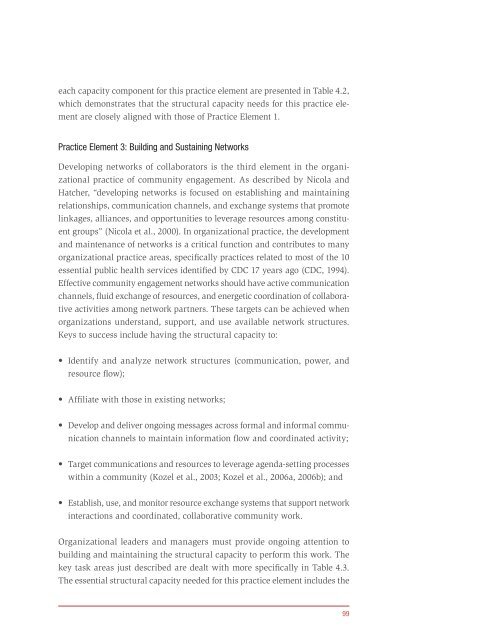Principles of Community Engagement (Second Edition)
Principles of Community Engagement (Second Edition)
Principles of Community Engagement (Second Edition)
Create successful ePaper yourself
Turn your PDF publications into a flip-book with our unique Google optimized e-Paper software.
each capacity component for this practice element are presented in Table 4.2,<br />
which demonstrates that the structural capacity needs for this practice element<br />
are closely aligned with those <strong>of</strong> Practice Element 1.<br />
Practice Element 3: Building and Sustaining Networks<br />
Developing networks <strong>of</strong> collaborators is the third element in the organizational<br />
practice <strong>of</strong> community engagement. As described by Nicola and<br />
Hatcher, “developing networks is focused on establishing and maintaining<br />
relationships, communication channels, and exchange systems that promote<br />
linkages, alliances, and opportunities to leverage resources among constituent<br />
groups” (Nicola et al., 2000). In organizational practice, the development<br />
and maintenance <strong>of</strong> networks is a critical function and contributes to many<br />
organizational practice areas, specifically practices related to most <strong>of</strong> the 10<br />
essential public health services identified by CDC 17 years ago (CDC, 1994).<br />
Effective community engagement networks should have active communication<br />
channels, fluid exchange <strong>of</strong> resources, and energetic coordination <strong>of</strong> collaborative<br />
activities among network partners. These targets can be achieved when<br />
organizations understand, support, and use available network structures.<br />
Keys to success include having the structural capacity to:<br />
• Identify and analyze network structures (communication, power, and<br />
resource flow);<br />
• Affiliate with those in existing networks;<br />
• Develop and deliver ongoing messages across formal and informal communication<br />
channels to maintain information flow and coordinated activity;<br />
• Target communications and resources to leverage agenda-setting processes<br />
within a community (Kozel et al., 2003; Kozel et al., 2006a, 2006b); and<br />
• Establish, use, and monitor resource exchange systems that support network<br />
interactions and coordinated, collaborative community work.<br />
Organizational leaders and managers must provide ongoing attention to<br />
building and maintaining the structural capacity to perform this work. The<br />
key task areas just described are dealt with more specifically in Table 4.3.<br />
The essential structural capacity needed for this practice element includes the<br />
99

















